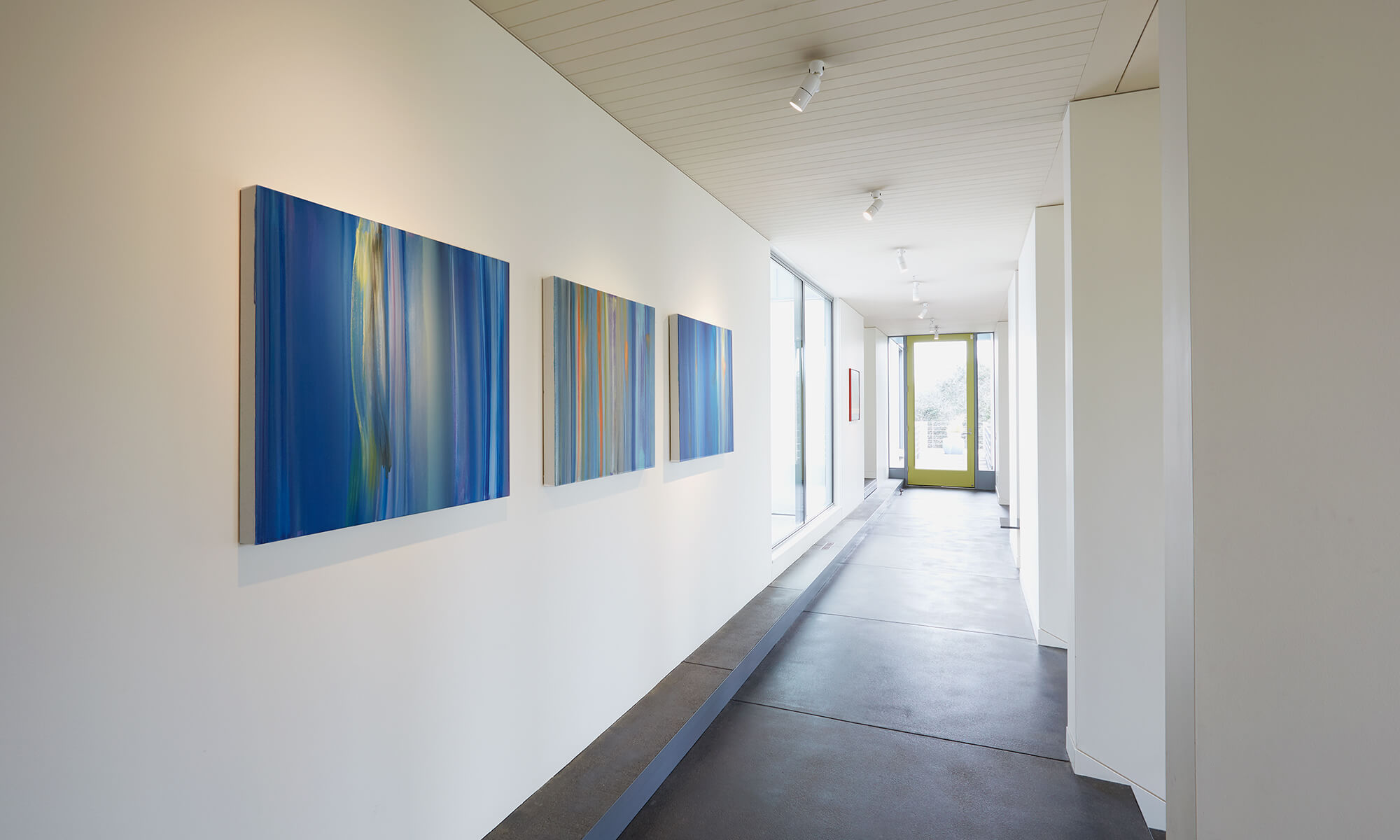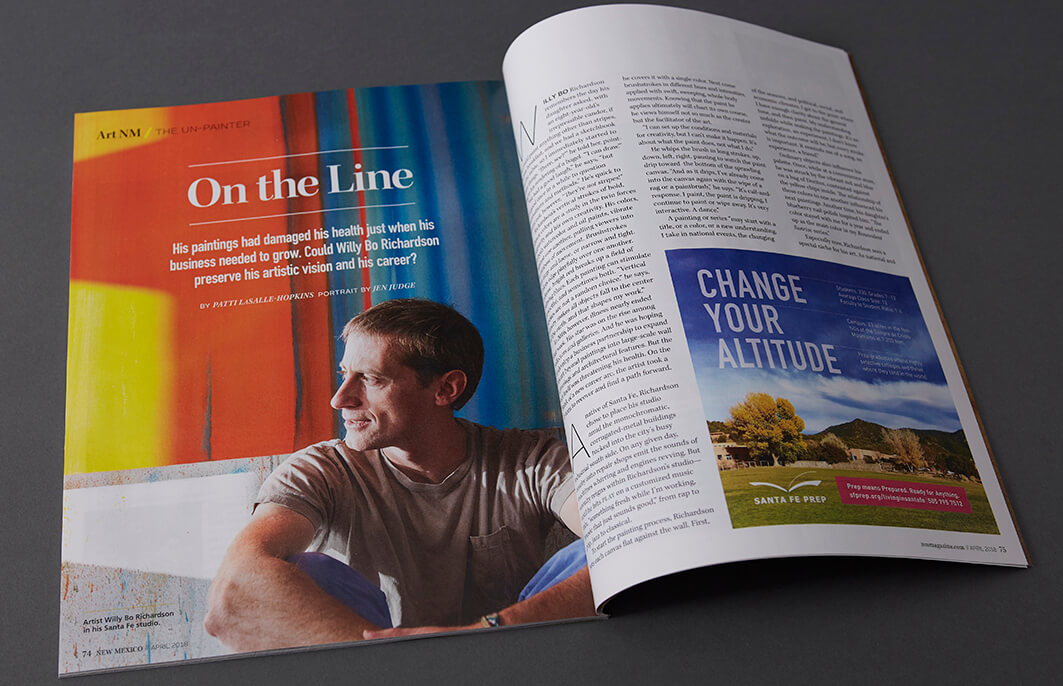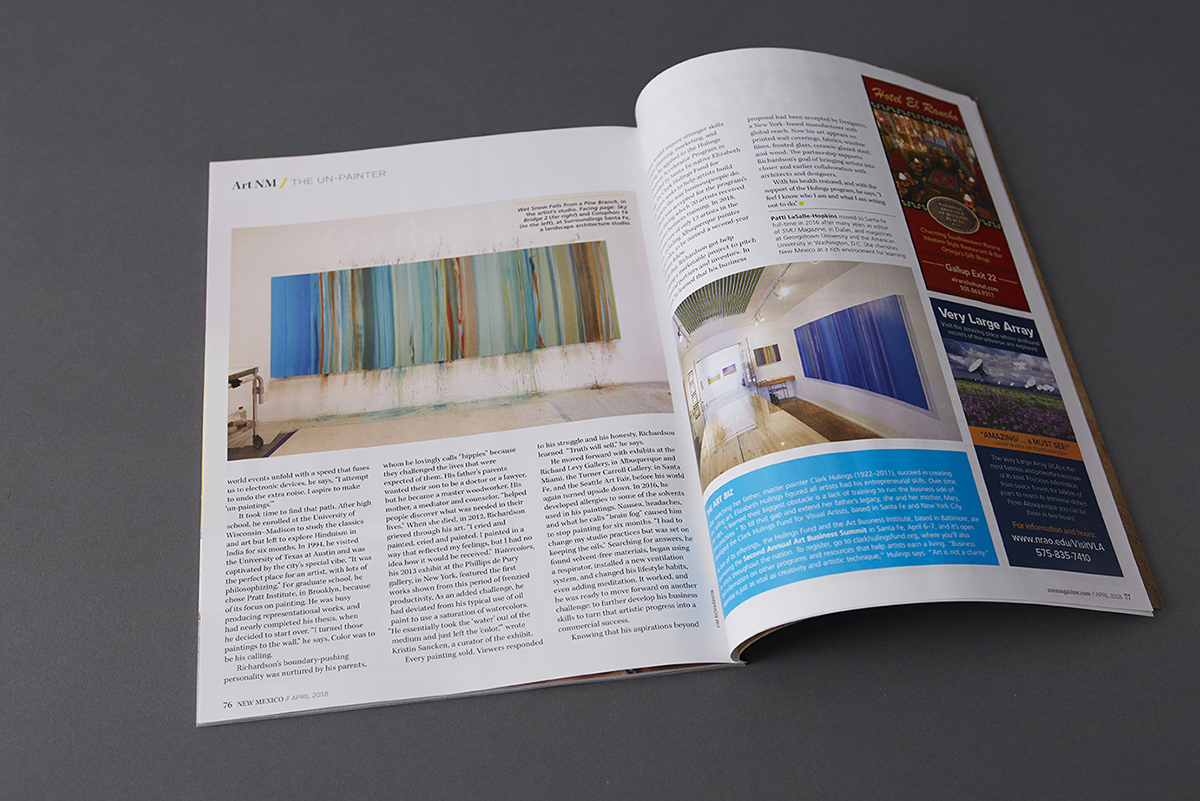“We had a good laugh,” he says, “but it’s good once in a while to question motivations and methods.” He’s quick to point out, however, “They’re not stripes!”
Richardson’s vertical strokes of bold, vibrant colors are a study in the twin forces of gravity and his own creativity. His colors, in both watercolor and oil paints, vibrate against one another, pulling viewers into a rainbow of movement. Brushstrokes are large and loose, or narrow and tight. Colors edge playfully over one another. A dense, bright red breaks up a field of calming blues. Each painting can stimulate or soothe, and sometimes both. “Vertical strokes are not a random choice,” he says. “Gravity makes all objects fall to the center of the earth, and that shapes my work.”
In 2016, however, illness nearly ended that work. His star was on the rise among collectors and galleries. And he was hoping to develop a business partnership to expand his art beyond paintings into large-scale wall coverings and architectural features. But the art itself was threatening his health. On the brink of a new career arc, the artist took a U-turn to recover and find a path forward.
A NATIVE OF SANTA FE, Richardson chose to place his studio amid the monochromatic, corrugated-metal buildings tucked into the city’s busy industrial south side. On any given day, nearby auto repair shops emit the sounds of machines whirring and engines revving. But serenity reigns within Richardson’s studio—until he hits PLAY on a customized music mix, “something fresh while I’m working, music that just sounds good,” from rap to pop, jazz to classical.
To start the painting process, Richardson sets each canvas flat against the wall. First, he covers it with a single color. Next come brushstrokes in different hues and intensities, applied with swift, sweeping, whole-body movements. Knowing that the paint he applies ultimately will chart its own course, he views himself not so much as the creator but the facilitator of the art.
“I can set up the conditions and materials for creativity, but I can’t make it happen. It’s about what the paint does, not what I do.” He whips the brush in long strokes, up, down, left, right, pausing to watch the paint drip toward the bottom of the sprawling canvas. “And as it drips, I’ve already come into the canvas again with the wipe of a rag or a paintbrush,” he says. “It’s call-and-response. I paint, the paint is dripping, I continue to paint or wipe away. It’s very interactive. A dance.”
A painting or series “may start with a title, or a color, or a new understanding. I take in national events, the changing of the seasons, and political, social, and economic climates. I get to the point where I have enough clarity about the general tone, and then paint. My understanding unfolds while making the paintings. It’s an exploration, an experiment. I don’t know what the outcome will be, but every stroke is important. It reminds me of a song, an experience, a friend.”
Ordinary objects also influence his palette. Once, while at a convenience store, he was struck by the vibrant red and blue on a bag of Doritos, contrasted against the yellow chips inside. The relationship of those colors to one another influenced his next paintings. Another time, his daughter’s blueberry nail polish inspired him. “The color stayed with me for a year and ended up as the main color in my Benevolent Sunrise series.”
Especially now, Richardson sees a special niche for his art. As national and world events unfold with a speed that fuses us to electronic devices, he says, “I attempt to undo the extra noise. I aspire to make ‘un-paintings.’”
It took time to find that path. After high school, he enrolled at the University of Wisconsin–Madison to study the classics and art but left to explore Hinduism in India for six months. In 1994, he visited the University of Texas at Austin and was captivated by the city’s special vibe. “It was the perfect place for an artist, with lots of philosophizing.” For graduate school, he chose Pratt Institute, in Brooklyn, because of its focus on painting. He was busy producing representational works, and had nearly completed his thesis, when he decided to start over. “I turned those paintings to the wall,” he says. Color was to be his calling.
Richardson’s boundary-pushing personality was nurtured by his parents, whom he lovingly calls “hippies” because they challenged the lives that were expected of them. His father’s parents wanted their son to be a doctor or a lawyer, but he became a master woodworker. His mother, a mediator and counselor, “helped people discover what was needed in their lives.” When she died, in 2012, Richardson grieved through his art. “I cried and painted, cried and painted. I painted in a way that reflected my feelings, but I had no idea how it would be received.” Watercolors, his 2013 exhibit at the Phillips de Pury gallery, in New York, featured the first works shown from this period of frenzied productivity. As an added challenge, he had deviated from his typical use of oil paint to use a saturation of watercolors. “He essentially took the ‘water’ out of the medium and just left the ‘color,’” wrote Kristin Sancken, a curator of the exhibit.
Every painting sold. Viewers responded to his struggle and his honesty, Richardson learned. “Truth will sell,” he says.
He moved forward with exhibits at the Richard Levy Gallery, in Albuquerque and Miami, the Turner Carroll Gallery, in Santa Fe, and the Seattle Art Fair, before his world again turned upside down. In 2016, he developed allergies to some of the solvents used in his paintings. Nausea, headaches, and what he calls “brain fog” caused him to stop painting for six months. “I had to change my studio practices but was set on keeping the oils.” Searching for answers, he found solvent-free materials, began using a respirator, installed a new ventilation system, and changed his lifestyle habits, even adding meditation. It worked, and he was ready to move forward on another challenge: to further develop his business skills to turn that artistic progress into a commercial success.
Knowing that his aspirations beyond the canvas would require stronger skills in strategic planning, marketing, and networking, he applied to the Hulings Fund Business Accelerator Program in 2017. Founded by Santa Fe native Elizabeth Hulings, the Clark Hulings Fund for Visual Artists seeks to help artists build their markets the way business people do. Richardson was accepted for the program’s first year, during which 20 artists received customized business training. In 2018, he became one of only 13 artists in the nation, including Albuquerque painter Juliana Coles, to be named a second-year accelerator fellow.
With that, Richardson got help developing a marketable project to pitch to potential partners and investors. In January, he learned that his business proposal had been accepted by Designtex, a New York–based manufacturer with global reach. Now his art appears on printed wall coverings, fabrics, window films, frosted glass, ceramic glazed steel, and wood. The partnership supports Richardson’s goal of bringing artists into closer and earlier collaboration with architects and designers.
With his health restored, and with the support of the Hulings program, he says, “I feel I know who I am and what I am setting out to do.”
New Mexico Magazine, by Patti LaSalle-Hopkins
New Mexico Magazine Online Version ->



4 Replies to “New Mexico Magazine: One the Line”